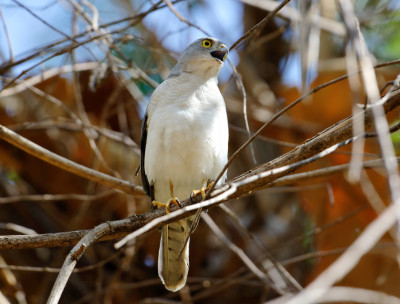2023
Michael Stewart
Investigating Migratory Patterns and Population Dynamics of Threatened Gray Hawks (Buteo plagiatus) in Texas
The Gray Hawk (Buteo plagiatus) is a small neotropical raptor with the northeastern periphery of its range being in Texas where it is state-listed as threatened. Conservation of the species has been hampered by significant knowledge gaps regarding the migratory behavior and population dynamics of Gray Hawks throughout their restricted distribution in the United States. We will deploy solar-powered GPS-GSM transmitters on five adult Gray Hawks within Webb County, TX, to track their movements for the first time in this region. A comparative analysis with tracking data from south Texas Gray Hawks will aid in assessing connectivity across their limited statewide distribution. Our study will document migratory patterns, quantify home range sizes, improve the understanding of habitat use, and gather essential data to inform a statewide population model. This foundational work is crucial for directing future research and shaping conservation strategies for Gray Hawks in the US. Furthermore, our project sets the stage for collaborative efforts to study the full annual cycle of Gray Hawks throughout their range, emphasizing the importance of continuous monitoring and conservation initiatives for this threatened species in Texas.
Samnang Eang
Slender-billed Vulture (Gyps tenuirostris) Population Monitoring and Ranging Behaviour at Siem Pang Wildlife Sanctuary, Cambodia
Our research project titled “Slender-billed Vulture (Gyps tenuirostris) population monitoring and ranging behaviour at Siem Pang Wildlife Sanctuary, Cambodia” aims to understand the movements, nesting preferences, ranging behaviour, and youth dispersal of the Slender-billed Vulture in Cambodia.
The research will be conducted at Siem Pang Wildlife Sanctuary in northern Cambodia by safely attaching GPS-GSM tags to four vultures, allowing our team to monitor their daily movements. The data will be analyzed to determine home-range and nesting sites, which will then inform targeted conservation interventions such as nest sites protection. The research will be undertaken by Rising Phoenix’s team, which is already experienced in the capture, tagging and safe release of the majestic birds.
The conservation of the Slender-billed vulture, listed as Critically Endangered on the IUCN Red List, is a top priority for Rising Phoenix and the Cambodia Vulture Working Group and the project is expected to provide robust and qualitative data on the species’ behaviour and preferences, informing effective and targeted conservation interventions in Cambodia and globally.
Kaushal Patel
Addressing the Knowledge Gaps in the Breeding Biology of the Forest Owlet (Athene blewitti) in northern Western Ghats
The Forest Owlet (Athene blewitti), an endemic, rare and unique diurnal owl species in India, was thought to be extinct for 113 years until its rediscovery in 1997. Currently listed as "Endangered" and legally protected under Schedule-I of the Wildlife (Protection) Act (1972), the species is found exclusively in the small and isolated pockets in Central India and the Northern Western Ghats, with significant populations in Melghat and the Dangs forests. Despite being known for 25 years, our understanding on species' ecology remains poorly understood and solely come from the Central Indian populations.
Nestled in the Western Ghats, the Dangs District emerges as a biodiversity hotspot that has received relatively scant attention despite its ecological significance. Throughout the years, the area has mourned the local extinction of numerous species due to threats like hunting and habitat degradation. The report of the forest owlet has heightened awareness for conserving the rich biodiversity of the Dangs region. This pioneering initiative aims to address this gap by investigating the breeding biology of the species in the Dangs forests, and factors impacting reproductive success. This research endeavor strives to make a substantial contribution to unveil the breeding biology of the species in detail to ensure its conservation prioritization in the region.
Arjun Kannan
Monitoring wintering Harriers at a super-roosting site in Velavadar National Park, India
Globally, raptorial birds have been on the decline. In Asia, grassland migratory raptors such as harriers have showcased alarming declines within and outside protected areas. Harriers in Asia migrate to the Indian subcontinent during winter. They congregate to roost communally in grasslands in large numbers and one such “super roost” of harriers is found in the Velavadar National Park (VNP), recorded in the 1990s. Recent studies have shown that the number of harriers congregating to this site has reduced by 50% in addition to pronounced declines in other important harriers roosts across India as well. My study proposes to continue the harrier monitoring program in VNP where there has been a gap in monitoring since 2015. The objectives of this research is to capture the changes in harrier population trends and demography in VNP over the last 9 years. In addition, I will be assessing the diet of harriers to understand the type of prey that is sustaining these “super roosts”. Finally, I will also conduct workshops for local capacity building to continue the long term harrier monitoring program in VNP. This research can help in generating vital data for the conservation of harriers and grassland habitats in India.
2022
Ericka Griggs
Prevalence and Diversity of Haemosporidians in Arctic Migrating First-Year Raptors
Avian malaria and haemosporidian parasites are common in birds worldwide, but the consequences of infection on the health of wildlife in the Arctic still remain unknown. Because raptors are top predators, they are important ecological indicators of an ecosystem’s health and biodiversity. As such, migrating first-year raptors present a unique opportunity to monitor these emerging infectious diseases in breeding raptor populations in the Arctic because any pathogens found within them were likely acquired on their natal grounds.
In this study, I will establish baseline infection status of first-year raptors, which will help resource managers identify potential threats to Arctic birds and to recognize future changes in these populations related to infection frequency. This work is novel because I will use stable isotope analyses to estimate the natal origins of individuals infected with these pathogens, to distinguish individuals from more southern latitudes from their Arctic congeners. Results from this study will not only inform future monitoring studies but also inform conservation decisions affecting raptor breeding populations and the health of biodiversity in Arctic regions. Finally, if successful in North America and with this funding, my goal is to replicate this work for Arctic breeding raptors captured at migration sites in Eurasia.
Evan Farese
The Diet of Suburban versus Natural Nesting Gray Hawks
Urban development has the potential to negatively impact many bird species, including raptors. As cities continue to sprawl, it is important to understand how species will react to novel environments to predict how they will fare. The Gray Hawk (Buteo plagiatus) is a neotropical raptor whose range extends into the Lower Rio Grande Valley (LRGV) of south Texas. The LRGV is one of the fastest growing regions of the United States; the population of the area doubled between 1980 and 2013. The Gray Hawk can exist in human-influenced habitats, having been observed nesting in suburban neighborhoods and city parks. Though the Gray Hawk is a widespread raptor, there is a dearth of information about the species, especially outside of the migratory Arizona population. Little research has been devoted to their diet and even less to their ability to utilize human-influenced habitats. This study will conduct novel research with two aims: to document and assess the diet of Gray Hawks in the LRGV and to compare the diets of hawks in suburban and natural areas. This will be accomplished by observing prey deliveries to nests in suburban and natural settings in the LRGV via nest cameras. Filling in this gap in our knowledge of Gray Hawks holds important implications in understanding how the species is able to exist alongside humans and how they will survive in a rapidly urbanizing area.
2021
Ugyen Kelzang
Evaluation of Palla’s Fish Eagle Habitat and Threats to its Conservation in Bhutan
The major reason for the declining Pallas's Fish Eagle population and its distribution range is the degradation and disruption of wetland habitats and nesting trees throughout its range. However, there is huge knowledge gap on this species in the world with no exception in the proposed study area. The habitats in the study area are under serious threat due to anthropogenic activities like hydropower projects, illegal timber extraction, forest fires, road construction, and other activities, and there is an increasing chance of extinction of this species from its current habitat if left unaddressed. Therefore, considering the above-mentioned rationale, the need to study their critical habitat is significant. This study therefore aims to assess the current habitat status, assess threats to its conservation, and create awareness to the local communities. Information on general habitat condition will be collected, the status of waterbirds and fishes will be documented, and existing threats to the birds will be assessed. The research outcomes will be made accessible to the general public at local, national, and international levels. Ultimately, locals will be sensitized to the conservation of the PFE as locals are the ones who literally live with the bird every day.
Maholy Ravaloharimanitra
Assessing the Nesting Success & Productivity of the Madagascar Fish-Eagle at Four Breeding Sites in the Maevatanana/Ambato-Boeny Region
The Madagascar Fish-Eagle (Haliaeetus vociferoides) is the largest bird of prey in the family of Accipitridae in Madagascar, and one of the rarest birds of prey in the World (Meyburg, 1986). It is among the top 100 of the most Evolutionary Distinct and Globally Endangered (EDGE) species and, due to the very low number of known individuals and the permanent threats to the species and its habitat, it is listed by the IUCN as Critically Endangered (IUCN, 2016).
Following wetlands and forests assessments carried out within and around the Maevatanana Ambato Boeni (MAB) Key Biodiversity Area (KBA) conducted by the Aspinall Foundation’s Madagascar team in 2017, 6 breeding pairs of Madagascar fish eagle have been recorded outside the area surveyed by Razafimanjato et al. in 2005-2006. This project has been designed to both increase knowledge about the Madagascar Fish Eagle in the area through research and monitoring and to improve the conservation of the identified population in conjunction with four local community associations that have been newly established to manage natural resources in the area.
Fiona Fern
Viruses in Vultures of Southern Africa
Vultures, as obligate scavengers, provide vital ecosystem services, unfortunately, they are currently undergoing drastic population declines across the globe, with some species decreasing by as much as 90%. While much research has studied threats such as poisoning, power line collisions, the traditional medicine trade and human persecution, little research has focused on infectious diseases.
As long-distance travelers and communal feeders, vultures have the potential to spread pathogens over great distances very quickly. Highly infectious Avian Influenza is currently running rampant across South Africa, devastating local bird populations and the poultry industry. The potential for zoonotic disease is also very real with the continued, albeit illegal, trade in vulture body parts for traditional medicine.
During this study, blood samples and throat and cloacal swabs will be taken to investigate whether vultures currently have or have had Avian Influenza or Newcastle Disease. If the results are positive, the viruses will by typed so that we may understand which strains of the viruses are prevalent and how it is spreading. If we find that the viruses affect vultures, we will consult with state veterinarians and nature conservation officials to find the best way to protect and treat them to reduce the spread.
Dries Engelen and Triin Kaasiku
Combining traditional falconry and modern tracking technology to unravel the movements of the enigmatic Levant Sparrowhawk Accipiter brevipes
One of the world’s largest concentrations of migrating raptors meet traditions of falconry in the Batumi bottleneck (Republic of Georgia). While falconry in Georgia is generally regarded as sustainable, killing of by-catch and illegal hunting still occur, threatening migratory raptors. The most common by-catch is the Levant Sparrowhawk (Accipiter brevipes), of which several hundreds of individuals are estimated not to survive their passage through the bottleneck each year.
As of 2018, we have been engaging local young falconers in different activities related to raptor conservation and research (e.g. migration counts, raptor ringing) to have them observe and appreciate these birds in a different way. In 2022, we aspire to take this initiative to another level by involving them in a tracking study of the Levant Sparrowhawk. In doing so, we aim to (i) unravel the migration routes of this understudied species (ii) to have falconers change their attitudes and practises towards Levant Sparrowhawks and other non-target birds.
Considering the power of modern animal tracking as a science communication tool, we strongly believe this will contribute to a greater appreciation of the species among the falconry community and lead to better understanding of this little-known raptor of the East African-Eurasian flyway.
2020
Ed Drewitt
Peregrines eat a huge variety of prey as a generalist avian predator. During their population recovery in the UK over the past 40 years there have been huge changes in the populations of prey bird species in many habitats across the UK, particularly in farmland and woodlands. In this study I will examine what peregrines are eating in urban locations across the UK, how this varies over seasons and whether the diet has changed over time (20 years) in relation to the conservation status of its prey species. By recording the feathers, wings and other body parts of prey found on and below urban peregrine sites, the species and numbers of individuals of prey provide some insights into what urban-dwelling peregrines are eating. This research is the first detailed diet study in the UK that includes at least ten different locations and the longest running prey study (23 years) from one city. As peregrines are declining in parts of their UK-range, knowing what urban peregrines eat and how this has changed over time has important implications in understanding why peregrines may be increasing or stable in urban habitats, in contrast to their counterparts in parts of the countryside.
J. Berton C. Harris, Joseph M. Kolowski, and Alan B. Williams
American Kestrels are familiar, charismatic raptors that are declining across the northeastern US. Loss and degradation of grassland habitats are likely important causes of the decline, but key research gaps limit our ability to draw conclusions. The advent of lightweight GPS transmitters presents an opportunity to refine our understanding of kestrel foraging habitat use and territory size. We propose to attach GPS transmitters to breeding kestrels in northern Virginia (three in pilot season, 20 overall). Our goal is to quantify time spent foraging in, and therefore relative importance of, four distinct categories of fields (cattle pastures, row-crop fields, hay fields, and native grasslands) to kestrels. We will also evaluate how territory size (which has only been estimated roughly for the species to date) is related to the habitat types found near the nest box, and how habitat use changes as the season progresses. This will be the first study to track kestrel movements at high resolution, and our results will reveal which kinds of fields are most productive and important for breeding kestrels. This information will be relevant to landowners and agencies in Virginia and across the northeastern United States, where the same four categories of fields dominate open areas.
Andrea Gibbons
Cooperative breeding has been the focus of intense scrutiny for decades, but in raptor species the adaptive function of the behavior is unclear. Even in the highly-studied Harris’s Hawk, the behavior is poorly understood. To provide further insight into cooperative breeding in raptors, I will evaluate the behavior in south Texas Harris’s Hawks through the lens of direct and indirect benefits. I suggest that the direct benefits of group life, such as increased hunting capabilities, are likely to shape cooperative behaviors in Harris’s Hawks. If this is true, the level of relatedness between helpers and breeders will be less important than the benefits of group life and will result in both unrelated and related helpers. I would expect broods to include mixed paternity/maternity from unrelated helpers, although this would not preclude some young from delaying dispersal to gain direct group life benefits. Alternatively, if kin selection (indirect benefit) is the driving force of cooperation for Harris’s Hawks, delayed dispersing young will be the main source of helpers in cooperative groups and mixed parentage in broods will be rare. No other published study has used genetic methods to assess pairwise relatedness among Harris’s Hawks within cooperatively breeding groups and among nestlings.
Robert Rosenfield
I propose to extend the long-term work on the breeding ecology and particularly the nesting phenology, of Peregrine Falcons in the central West Greenland study area near the town of Kangerlussuaq. Our work will well-complement the multi-decadal efforts begun in the 1970s by Drs. Bill Burnham and William Mattox, along with others, that dedicated much of their lives to document and provide conservation insights into Arctic biodiversity. We highlight that our research has been explicitly identified by the international Arctic Falcon Specialist Group as vital to the comprehensive assessment of circumpolar status of Peregrine Falcon populations and their and potential responses to recent climate change.






